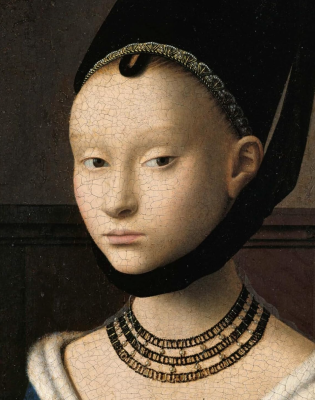This book was published as the catalogue of an exhibition held at the Rijksmuseum from October 1, 2021 to January 16, 2022, but it easily stands alone as an engaging introduction to the artistic and social significance of portraiture in Renaissance Europe. The authors (all Rijksmuseum curators) weave their narrative around an ideal selection of portraits produced in the present-day Netherlands, Germany, France, and Italy in the fifteenth and sixteenth centuries. In the catalogue, canonical works that could not be lent are illustrated alongside exhibited portraits to support key points. A summary checklist at the back of the book records the actual contents of the show (a stratagem frequently adopted to provide flexibility during the logistical challenges of lending during the Covid-19 pandemic). While built around the Rijksmuseum’s own collection, the 110 objects exhibited included loans from 49 museums and private collections in Europe and the US. This assemblage of paintings, drawings, prints, and sculptures would have been impressive under any circumstances, with works by major artists from Hans Holbein, Jan van Scorel, Marten van Heemskerk, and Anthonis Mor to Antonello da Messina, Domenico Ghirlandaio, and Lorenzo Lotto. Some portraits by less familiar artists are equally fascinating for the vivid likenesses they present, such as Johan Gregor van der Schardt’s polychrome terracotta Self-Portrait (1573, Rijksmuseum), so lifelike despite its diminutive scale that it appears (as Castiglione or Van Mander might have said) to lack only speech.
Following a short introduction by Van Dijk and Ubl, the text is organized thematically, mirroring the exhibition’s structure. Each chapter highlights a particular portrait type or function, comprising devotion, family, power, marriage, beauty, intellect, paper art, and self-portraiture. From the first paragraph on, the reader is immersed in the world to which these images and their subjects belonged, as the authors explore aspects ranging from fashions in dress to symbolic iconography. Issues of gender and social class inevitably play a large role, since an individual’s status in the early modern world was largely relational. Inevitable, too, is the emphasis on portraits of the elite, but distinctions between aristocratic and middle-class modes of representation are examined. Femininity is explored primarily through conventional tropes of marriage portraiture and physical beauty, with only brief attention to works by women artists. (The exhibition did include Sophonisba Anguissola’s Self-Portrait, c. 1556 [Łańcut, Muzeum-Zamek w Łańcucie] and her groundbreaking family portrait, The Chess Game, from Poznàn, recently available again to Dutch viewers in the retrospective of Anguissola’s work at Rijksmuseum Twenthe, Enschede.) Also shown were Jan Mostaert’s Portrait of an African Man [Christophle le More?] (c. 1525-30, Rijksmuseum), and Albrecht Dürer’s Portrait of an African Man (black chalk, 1508, Albertina), but race and ethnicity are treated only summarily. Indeed, rather than parsing difference, analyses of pictorial types and social aspirations explore commonalities of content and purpose shared by artists and their clients north and south of the Alps. This approach succeeds best when applied to elite patronage, since many noble families were connected by international bonds of marriage even as global commerce broadened the perspectives of bourgeois consumers and their portraitists.
The content overall is more cumulative than synthetic or analytical: each chapter weaves together precise observations about individual works with concise explanations of how specific details of costume, pose, or format fit within larger patterns of portrait production. Biographical information about artists and their clients is introduced where it serves the narrative, but the thematic arrangement means that a reader must browse through several chapters to assemble a full account of any one individual. This also leads to occasional repetition, but the text throughout is clear, engaging, and accessible while reflecting up-to-date scholarship on Renaissance portraiture and its social context.
On balance, this book examines portraiture less from the artist’s than from the consumer’s point of view. As the authors note, with reference to Alberti and other primary sources, the primary goal of early modern portraits was not to garner attention as works of art but to preserve the memory and positive reputation of those depicted. The book is beautifully produced, with many full-page color plates. Given that so many of the works are bust portraits, this has the effect of presenting the reader with an album of vivid, often nearly life-size faces: a community of individuals whose distinctive features and expressions convey a lively immediacy. At once historically contingent and instinctively appealing, they invite contemplation of the enduring mystery of human character.
Stephanie Dickey
Queen’s University
Kingston, Canada
